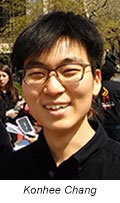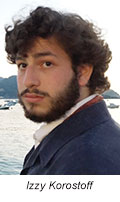Konhee Chang, Rebecca Heilweil and Izzy Korostoff: Digital Humanities Fellows

University of Pennsylvania students Konhee Chang, Rebecca Heilweil and Izzy Korostoff were chosen as the inaugural fellows with the Price Lab for Digital Humanities. The fellowships took place over the summer.
Mr. Chang, a double major in visual studies and economics, is about halfway through a project to turn Kandinsky’s Circles in a Circle painting into a musical score.
Each of the 50 or so circles and lines will be assigned a musical note according to Kandinsky’s theories on sound and image, and the ultimate tune will depend on which order the viewer chooses to “play” those notes, similarly to how a painter selects the sequence to paint.
“I’m interested in this relationship between seeing and hearing,” Mr. Chang said. “I wanted to look at paintings and imagine a sound that could be a musical representation.”
Ms. Heilweil studied media coverage of free speech. Ms. Heilweil, a junior who studies history and political science, wanted to delve into how the notion of free speech has changed in the past five decades with a specific focus on media coverage dips and peaks.
“In the 1960s, the free speech movement is a far-left movement, at least a young leftist movement on college campuses,” she said. “Today when people talk about free speech, you normally expect that coming from conservatives or traditionalists or constitutionalists, which is the exact opposite image of the person you’d imagine in the 1960s.”
She has continued the research and analysis as an independent study to better understand why media companies make the decisions they do. It may become her senior thesis topic.

Mr. Korostoff, a junior in the urban studies department, studied the design of Philadelphia streets in the 20th century. He dedicated his summer to what he describes as a “digital investigation of hierarchies of streets in Philadelphia in the early 20th century,” he said. “As I worked through this project, it became evident that an architectural hierarchy of street types creates a distinct racial and socioeconomic hierarchy in turn.”
Mr. Korostoff set out to explain why well into the 20th century, Philly appeared to remain less segregated than similar cities. The answer seemed to come down to scales of measuring integration.
“Philadelphia has extraordinarily large blocks. They came to be cut up into smaller streets early in the city’s history, which produced interesting courts and alleyways. These irregular spaces have been looked down upon in the city’s history,” he said. “I made the case that they’re a valuable form of organic growth, and that this actually provided the city with the diversity of urban form that let a high level of racial integration persist.”
